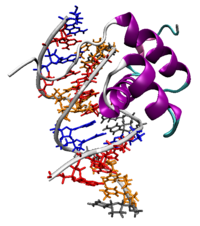
Photo from wikipedia
The Ventx family is one of the subfamilies of the ANTP (antennapedia) superfamily and belongs to the NK-like (NKL) subclass. Ventx is a homeobox transcription factor and has a DNA-interacting… Click to show full abstract
The Ventx family is one of the subfamilies of the ANTP (antennapedia) superfamily and belongs to the NK-like (NKL) subclass. Ventx is a homeobox transcription factor and has a DNA-interacting domain that is evolutionarily conserved throughout vertebrates. It has been extensively studied in Xenopus, zebrafish, and humans. The Ventx family contains transcriptional repressors widely involved in embryonic development and tumorigenesis in vertebrates. Several studies have documented that the Ventx family inhibited dorsal mesodermal formation, neural induction, and head formation in Xenopus and zebrafish. Moreover, Ventx2.2 showed functional similarities to Nanog and Barx1, leading to pluripotency and neural-crest migration in vertebrates. Among them, Ventx protein is an orthologue of the Ventx family in humans. Studies have demonstrated that human Ventx was strongly associated with myeloid-cell differentiation and acute myeloid leukemia. The therapeutic potential of Ventx family inhibition in combating cancer progression in humans is discussed. Additionally, we briefly discuss genome evolution, gene duplication, pseudo-allotetraploidy, and the homeobox family in Xenopus.
Journal Title: International Journal of Molecular Sciences
Year Published: 2022
Link to full text (if available)
Share on Social Media: Sign Up to like & get
recommendations!